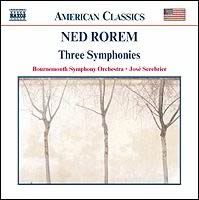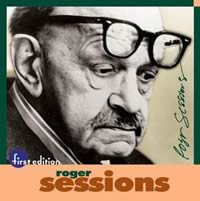American Symphonies on Naxos and First Edition
|
Grant Chu Covell [September 2003.] Whether one looks forward or back, Naxos and First Edition Music are two labels making significant contributions to American symphonic music. It’s an expensive genre. To get to the concert stage, orchestral works require extensive score preparation and copying, constructive rehearsal time, a conductor’s devotion, the blessing of several arts organizations and generous funding. Recording and distributing a CD takes more of the above. Here are a few recent items, new recordings alongside welcome reissues. Earlier, I discussed two Hovhaness symphonies on Naxos and First Edition Music.
George ROCHBERG: Symphony No. 5 (1984-85); Black Sounds (1965); Transcendental Variations (1975). Saarbrücken Radio Symphony Orchestra, Christopher Lyndon-Gee (cond.). Naxos 8.559115 (http://www.naxos.com/). Years ago I heard the Cleveland under Dohnanyi play Ruggles. In front of me sat a burly man in a loud plaid jacket. I assumed he was more accustomed to sports arenas or the battlefield than concert halls. At a pause in the Ruggles, he turned to his companion and delivered three evenly weighted words in a tone that commanded authority: “This is good.” Well, needless to say, that pronouncement made my day because it was true, and something that I imagine Ruggles or his friend Ives might have said. Those three words apply well to Rochberg’s Fifth. A lot of hardcore serialists are pissed at Rochberg for leaving the fold. In the mid-’60s, he was an acclaimed master of 12-tone composition. The magnificent and muscular Second Symphony of 1965-66 (CRI 768) is the capstone of this period (the Second String Quartet, which Rochberg considers his best serial effort, is on VoxBox CDX 5145). But dissatisfaction with serialism’s relevance and its range of expression coincided with a personal tragedy, and Rochberg’s style grew to encompass tonality. A bundle of string quartets, Nos. 3 to 6 (New World 80551-2), give evidence of this new all-inclusive style: Beethoven, serialism, Bartók and Mahler might appear in the same movement or in separate successive movements. The result is dizzying and eclectic. Some will be annoyed while others will be titillated. Offering an alternative in the “serialism vs. chance” battle of the 1950s and ’60s, Rochberg became the granddaddy of polystylism, giving mediocre and talented composers the green light to ransack or honor the past. By cozying up to tonal and pre-serial music with its indisputably broad range of expression, Rochberg opens himself to direct comparison with the models he reveres. There are no equivalent touchstones in the land of serialism where hermetic academe is the best judge. Anybody can evaluate Rochberg now. Luckily, he’s an exceptionally gifted technician and mimic, and plumbs his resources’ emotional gamut well. Alongside the Fifth Symphony, Naxos presents two such imitative works. Black Sounds for winds and percussion is an overt homage to Varèse, whom Rochberg had the good fortune to know well. Stumble over it in the dark and you’ll think it the real thing. While Naxos rarely duplicates itself, the label released another version on 8.559120. Transcendental Variations, an orchestrated movement from Rochberg’s Third String Quartet, is completely tonal and could easily share a bench with Tchaikovsky or Grieg. (In the Sixth Quartet, a set of variations on the Pachelbel Canon crosses the Baroque with Strauss!) Rochberg’s technical mastery and fluency with the late 20th-century Zeitgeist is evident in each of the seven variations. It’s a pretty creampuff that comes as a shock after the violence and desolation of Black Sounds and the astringent Fifth. Until this first recording, Symphony No. 5 hadn’t been played since its 1985 premiere performances. At about half an hour, the symphony is a single-movement wild ride through craggy dissonance and lush romantic repose. The first section begins with a gritty rocking figure in the strings that hovers over blunt brass declamations. Pages of knotty dissonance hide a five-note-turn figure which eventually stands on its own, hinting at the world of Mahler’s Ninth. It’s hard to pinpoint explicit quotes, but the music will pass through a familiar chord, or two lines will seem to have been momentarily lifted from the Austrian’s symphony. There’s also an upward brass surge reminiscent of the Adagio of the incomplete Tenth. Rochberg’s mastery of diverse styles is most effective when, as here, he forges something new, which is to say, less blatantly imitative. At the center of the symphony the horns indulge in a remarkable threnody, exquisitely played by the members of the Saarbrücken Radio Symphony Orchestra. There are further oases of tranquility, including an extended solo-cello rhapsody, which are all rocked by the music’s relentless argument. It’s a fine piece, and a damn shame that it had to wait so long for a recording. Don’t worry about categorizing Rochberg or taking polemical sides. If you want to hear good music, then this Naxos Rochberg is for you. The range of expression in the Fifth is both challenging and rewarding, and the Saarbrücken under Lyndon-Gee extracts every last ounce. This is good.
Walter PISTON: Symphony No. 2 (1943); Symphony No. 6 (1955). Seattle Symphony, Gerard Schwartz (cond.). Naxos 8.559161 (http://www.naxos.com/). Walter PISTON: Serenata (1957); Symphony No. 5 (1954); Symphony No. 7 (1960); Symphony No. 8 (1965). The Louisville Orchestra, Robert Whitney and Jorge Mester (cond.). First Edition FECD-0010 (http://www.firsteditionmusic.com/). Your musical education is incomplete if you haven’t worked through one of Piston’s no-nonsense textbooks. More familiar today as the author of Harmony (1941), Counterpoint (1947), and Orchestration (1955), Piston’s all-business demeanor suggests a dry, perhaps pedantic musical style. Acclaimed and beloved as a teacher, he taught Carter, Bernstein, Harbison, Rzewski, Leroy Anderson and many others who passed through Harvard. These two new discs with five symphonies between them will give you a lot to chew on, and plump Piston’s languishing discography, The Incredible Flutist being hardly representative. Fruit of its partnership with Gerard Schwartz and the Seattle Symphony, Naxos has reissued two symphonies recorded in the late 1980s that appeared originally on Delos. First Edition Music has collected four world premiere Louisville Orchestra recordings from LPs. This is one of the best First Edition releases yet. It’s great to hear music played so well. Piston’s work is efficient and concise. Four of these five symphonies are in three movements; the Sixth takes the traditional four. The three-movement symphonies fall into a pattern. The first two movements are usually in a minor mode, the last in the major. The first movement presents a cogent musical argument. The longest movement, a lyric Adagio with muted strings, is in the middle, and the conclusion is a quick and lively rondo flourish. In fact, none of these symphonies’ final movements is longer than five minutes and usually half to a third of the length of what precedes. Piston’s style rests on a neoclassical foundation. His teacher Nadia Boulanger’s influence is indelible. Some moments suggest Shostakovich, without the foursquare marches and self-mockery. Piston possesses a wide emotional range, unlike Stravinsky’s snide neoclassicism. He also shies away from sarcasm. Perhaps due to Piston’s frequent use of open fourths and fifths, a decidedly American tone is struck, its gravitas akin to Bernstein’s serious concert music or Copland in a nonpopulist mood. Taken in separate sittings, Piston’s symphonies are worth getting to know. The Second Symphony is charming, certainly the most naïve and optimistic of these five. A jerky, colloquial dance with percussion interrupts the opening Moderato’s gorgeous, Nielsen-like first theme in what could be a contrast between city and country. The central Adagio is a lazy summer afternoon, complete with languorous clarinet solos. The final Allegro, a snappy Rondo, is an urgent surge built with upwardly moving gestures flashily orchestrated. Barber’s Violin Concerto (1941) and Knoxville: Summer of 1915 (1947) are from the same decade with similar language, but Piston is the tidier craftsman working to a higher standard. The Fifth is strangely inscrutable. The movements’ moods are hard to reconcile to the same opus. An atmospheric Lento, like the credit roll for a film noir, builds to the Fifth’s initial Allegro movement. A somber Adagio surprises with its similarity to those of Shostakovich. The despair is lifted in the concluding Allegro, and we’re in Technicolor. Beginning mysteriously, like a sleepy giant emerging from a slumber, the initial movement of Piston’s Sixth is a sinewy line stretching from beginning to end. The short Scherzo with challenging string writing is a flighty and neurotic spurt in contrast to the following stately and melancholy Adagio, the symphony’s longest movement. The last Rondo-like movement has the bustle of a train station at rush hour. It’s a bright bubble whose uncomplicated optimism washes away all the previous moods. Sometimes I wish Piston had dwelled more on his finales. As the numbers climb, Piston’s symphonies grow more compact yet remain tonal and precisely minted. Fugatos and counterpoint become more frequent. They also grow increasingly pessimistic, as if Piston were preoccupied with something trying. However, the short Serenata, penned between the Sixth and Seventh, is a welcome shaft of light. Yes, it’s in three movements. But it’s infused with joyous energy like Roussel’s spiky late style. The only mono offering on the First Edition disc, at less than 12 minutes it ought to be a concert opener. The Seventh begins in an insistent minor. Its fluid fugatos and wind groupings imply an admiration of Bartók’s Concerto for Orchestra. The central Adagio is another lonely place, one of Piston’s best searching and soulful movements. The finishing Rondo switches to the major and bounds off into the sunset, however, unlike the conclusions of the Fifth and Sixth, not oblivious to what preceded it. The Eighth follows the same pattern, testing this listener’s endurance. The starting Moderato and the central Lento are shadowy but rich with counterpoint and contrasts in orchestration. Low strings and bassoon are prominent in these gnarly chromatic essays. The trifle that closes the Eighth maintains the minor mode, trying valiantly to shake off the gloomy mood. The Seventh and Eighth are concertos that have forgotten their soloists. The Louisville tracks, put down decades ago, stand up to today’s recording standards. The Seattle folks’ edge is better microphone placement and the rich detail of digital recording. Also, the differences between the Second and Sixth are greater than between the Fifth, Seventh and Eighth. Both orchestras play with exuberance and dedication. Piston is well served. Amy BEACH: Piano Concerto in C-sharp minor, Op. 45 (1898-99); Symphony in E minor, “Gaelic,” Op. 32 (1894-96). Alan Feinberg (piano); Nashville Symphony Orchestra, Kenneth Schermerhorn (cond.). Naxos 8.559139 (http://www.naxos.com/). In 1892 Antonin Dvorák came to the USA. He had been asked to do two things. The first was to run the National Conservatory of Music in New York. The second was to help American composers discover their own musical voice and wean them away from the predominantly Austro-Germanic European models they’d been following. Dvorák’s pronouncement, delivered in 1893, was that American composers should derive their melodies and themes from those of the African-Americans, spirituals, work songs, and the songs sung by slaves and minstrels becoming the sources for the new American concert music. You could say he was forecasting the emergence of jazz. Dvorák’s own American symphony, “From the New World,” received its premiere in New York on December 16, 1893 and in Boston 13 days later. Dvorák did not in fact use African-American melodies. As he put it: “I have simply written original themes embodying the peculiarities of the Indian music .” The symphony was a grand success. In the 1890s, nearly all established American composers had studied in Europe and were aware of Dvorák’s stature. However, some of them, such as John Knowles Paine and George Whitefield Chadwick, were wary of Dvorák’s insistence on African-American or native sources. They preferred to derive their inspiration from whatever sources interested them. Irish and Scottish tunes were among their favorites. Amy Beach, a foremost American composer and pianist of the time and the first woman to rise to such prominence, fundamentally agreed with Dvorák. Americans should utilize themes connected with their heritage. As a Boston native, a “Northerner” supposedly unfamiliar with the music of the African-American, she chose material from Ireland, the land of her ancestors, for her symphony. We can presume that Beach, active in the Boston musical scene, took in the local premiere of Dvorák’s “New World” Symphony. The Czech’s work does seem to have been an influence. More importantly, there is an affinity with Chadwick’s Second (1883-85) and Third (1894) Symphonies, mature products by the most accomplished American symphonist of the day. Chadwick’s Third has the same breadth and liveliness of Dvorák’s early symphonies such as the Sixth. (Järvi and the Detroit Symphony’s set of the two on Chandos CHAN 9685 is magnificent.) In fact, it’s been suggested that Dvorák was influenced by Chadwick’s Second, though it was played in Boston only in 1886 and ’90. Beach’s symphony is a substantial four-movement work. It’s busy and earnest, just short of being intense. The opening quivering suggests the expectant start of Mendelssohn’s G-minor Piano Concerto, but Beach soon balances a soaring melody over this fidgety accompaniment. There is nothing unnecessary in the well-thought-out first movement sonata allegro. From introduction to coda, Beach effortlessly weaves and develops the themes. The orchestration is thick, more like Brahms than Dvorák or Chadwick. Trombone underpinnings suggest the somber Edwardian Elgar. The Scherzo’s lighter mood is a relief. The second movement begins with a charmingly rustic and lilting oboe theme, soon taken up by the strings in a sprightly variation. If the Scherzo is a nod to Mendelssohn, then the drama and tender romance of the slow movement with violin and cello solos look to Bruch. Beach’s material feels the most overtly Irish here, fulfilling her wish to convey “their laments their romance and dreams. ” The finale returns to the seriousness of the Allegro. It’s a fine symphony and the Nashville Symphony Orchestra led by Kenneth Schermerhorn conveys all its wonders. I can imagine a looser reading wherein perhaps Beach’s details and coherence would be sacrificed. After its premiere, the symphony was programmed in Chicago (1897), Philadelphia (1914 and ’18) and Detroit (1918), as well as overseas. Beach’s Piano Concerto completes the disc. In four movements like Brahms’ Second, it’s hefty much like the E-minor Symphony. Back in 1885, Beach made her dazzling debut with the Boston Symphony playing Chopin’s Second. Her concerto, premiered 15 years later, blends similar passagework and harmonic suspensions with a Brahmsian sensibility. Alan Feinberg makes a great case for the work, delivering pages of broad chords and doubled octaves with nuance and expressive shape. Like the Chopin concertos, there is much orchestra-vs.-piano combat. In its supportive role, the orchestra sometimes overwhelms the piano. A more delicate texture appears in the Perpetuum mobile of the second movement where orchestra and piano cavort like lace curtains caught in a spring breeze. Momentarily Wagnerian with its low brass opening, the brief slow movement is a languid rhapsody before the sparkling Rondo conclusion. It’s grand that Naxos has devoted an entire disc to two of Beach’s most significant orchestral works (her Mass is another). Recordings of Beach’s songs and more intimate chamber music are plentiful. Many know Beach’s music through anthologies of women composers and collections of art songs. The orchestral works reveal the side of Beach that made her “one of the boys,” as Chadwick called their generation of Boston composers. Beach was also among the first to contemplate a distinctive nationalist style while actually maintaining European traditions. History has categorized her as conservative, even though the very nature of her productivity required overcoming traditional and societal restrictions. Her contributions are necessary to understand late 20th-century American orchestral music and orchestral music of the period in general. Folks who scour the repertoire for new orchestral experiences from Liszt to Bliss would do well to snap this up.
Ned ROREM: Symphony No. 1 (1950); Symphony No. 2 (1956); Symphony No. 3 (1958). Bournemouth Symphony Orchestra, José Serebrier (cond.). Naxos 8.559149 (http://www.naxos.com/). This Xenakis fan has always kept Rorem at a distance. Contemporary song writing, even the very best, has always been unfathomable to me. My tastes are stuck on the big cycles of Schubert and Schumann, with occasional forays into Mahler, Debussy, Ravel and the Beatles. Nonetheless, it’s clear that Rorem is very good at what he does. This is one of Naxos’ best-sounding releases, collecting all three of Rorem’s symphonies in time for his 80th birthday. These are tonal and approachable compositions, played with abundant warmth and finesse by the Bournemouth Symphony Orchestra. Written in France, the symphonies dress typically American traits (jazz, the Frontier Spirit, the commotion of the city) in a transparent French palette: the prairie seen through a glass of pastis. The music flows effortlessly; it’s evident that Rorem is comfortable with what he wants to say and how to say it (completely unlike Piston’s symphonies, which seem labored despite their craft). Rorem is expert at transitions from one melody to another, using instrumental combinations to bring out new ideas or amble towards another mood. This is most evident in the Second’s wide-ranging opening movement, whose length and stature dwarf the two short movements that follow, a delightful Tranquillo with a naïvely charming melody and an impish Allegro. Despite its assertive opening and a recurring medieval-sounding chorale, the First is nice to listen to but lacks the durability and consequentiality of the Second and especially the Third. The five-movement Third begins with a solemn Passacaglia built from a gently rocking G-E-F-D motive that emphasizes the falling thirds. A tiny, bustling Allegro follows on its heels like a cheery taxi ride through a big city. Then comes a short, perfectly balanced Largo. The last two movements, an Andante followed by an Allegro, contain greater weight. The Andante is the symphony’s heart, a leisurely paced exploration of a continual melody. The closing Allegro is a Rondo with a jubilant theme grandly introduced by trumpets. Rorem’s fans will of course jump at this release. The music does sound extraordinarily clear, well balanced, and superbly played by José Serebrier and the Bournemouth Symphony Orchestra. One hears the delicate harp even when it supports other instruments. The well-placed percussion never overwhelms, e.g., the snare drum in the opening of the Third and timpani in the finale of the Second, but punctuates perfectly. I’m sure Rorem is pleased.
After talking of Piston and Rochberg, it’s impossible not to mention Roger Sessions, one of the best 20th-century symphonists. The traversal through CD issues of his symphonies would be 1, 2 and 3 on CRI 573, 4 and 5 on New World 80345, and 6, 7 and 9 on Argo 444 519-2. Sessions’ music, especially the symphonies, is infrequently recorded, and so FECD-012 with the Divertimento for Orchestra and Idyll of Theocritus is particularly welcome. Sensual like Berg but with Schoenberg’s elbow-in-the-gut rhythms, this is a great introduction to Sessions’ elastic and virile music. Once labeled difficult and gnarly, Sessions is easy compared to Ferneyhough or Xenakis. The Divertimento comes between the Fourth and Fifth. Its five movements fill lighter forms (Prelude, Aria, Toccata, Perpetuum mobile and Epilogue) with Sessions’ assured orchestration and serial language. Each of the Divertimento’s short movements maintains a definitive character. The Aria is especially striking for the way the violins wander lovingly at their top register. Idyll of Theocritus for soprano and orchestra is a sprawling work. Sessions’ flowing setting of the English text, sung by Audrey Nassaman, is remarkable in its eloquence and sinuous melodic line. Sessions’ Seventh was recorded by the Louisville Orchestra under Peter Leonard and released on an LP (LOU 776). Here’s hoping it will soon be reissued. With vivid graphics featuring composer photos, the First Edition Music CDs are smart reissues of 20th-century American music. Like the LPs they replace, many of these CDs contain world premiere recordings. It’s exciting to hear the Louisville Orchestra again. The breadth of the CDs issued attests to the diversity of American orchestral music and the accomplishment and versatility of the Louisville and its conductors, Robert Whitney and Jorge Mester. Some discs should satisfy the demand for popular composers such as John Corigliano, whose music has ridden a wave due to his accessible style. FECD-0002 with the Tournaments Overture (1965), Elegy (1965), Concerto for Piano and Orchestra (1968), and Gazebo Dances (1974) gives evidence of his work before the acclaimed symphonies, the opera The Ghosts of Versailles, and recent film scores.
Other composers will appeal because they’ve flirted with the exotic. Henry Cowell and the recently departed Lou Harrison have both maintained solid ground at the fringe. FECD-0014 has Harrison’s Suite for Symphonic Strings (1960) and Strict Songs I-IV for Eight Baritones with Orchestra (1951-55). Both bright works are the result of Harrison’s exploration of gamelan and non-Western scales and modes. This performance of the Suite is more energetic and less refined than that on Argo 444 560-2, with Dennis Russell Davies and the American Composers Orchestra. There are also two additional movements and they’re all in a slightly different order. Notes in the booklet are reproductions of Harrison’s original calligraphy. Cowell’s disc, FECD-0003, contains Hymn and Fuguing Tune No. 3 (1954), Ongaku for Orchestra (1957), Symphony No. 11, “Seven Rituals of Music,” (1954) and Symphony No. 15, “Thesis” (1961). These are late works in varied styles by one of Harrison’s teachers. The Hymn and Fuguing Tune could be mistaken for Ives by its tonal simplicity and naïve grandeur, whereas Ongaku reflects Cowell’s fascination with the gamelan. Symphony No. 11, “Seven Rituals of Music,” is a quirky blend of motives reflecting work, play, love, war, et al. distinctively orchestrated and cleverly intermingled. The gamelan percussion sound of work overlaps a Scottish-sounding theme suggesting play. Symphony No. 15, “Thesis,” lacks a program. Its short movements, like all these works, demonstrate Cowell’s keen ear and preference for pentatonic scales and motifs.
Sometimes music is the best way to document history. FECD-0007, devoted to Karel Husa, reissues the orchestral version of the riveting Music for Prague 1968, his response to the Russian incursion into Czechoslovakia. The devastating Apotheosis of this Earth (1971), for choir and orchestra, completes the disc. I confess a soft spot for Music for Prague 1968. I was in Prague months after the 1989 “Velvet Revolution,” as the city was awakening from its oppressive slumber, flexing newfound capitalist muscle and proudly celebrating its history. It was a wonderful time in a beautiful city. They were also restoring the names of historical monuments and some of the subway stations. Lacking fluency in Czech, following maps was doubly difficult. I recall, perhaps incorrectly, that the Communist regime forbade the performance of several movements of Smetana’s Má vlast because of their nationalistic subjects. One of those banned traditional tunes is the Cantus firmus of Music for Prague 1968. [More Grant Chu Covell, Mostly Symphonies]
[Previous Article:
Dear La Folia 12.]
[Next Article:
Göteborg’s Latest Duo, and Others]
|








